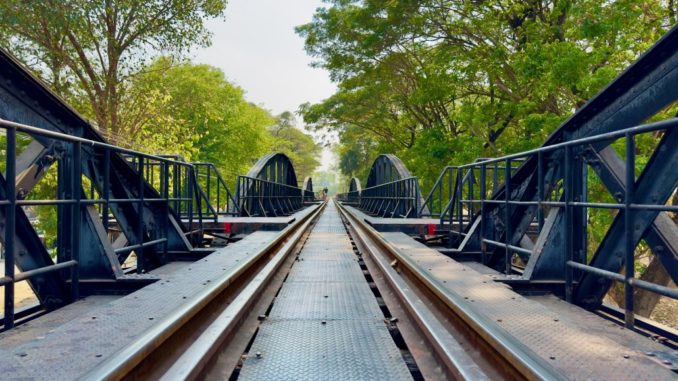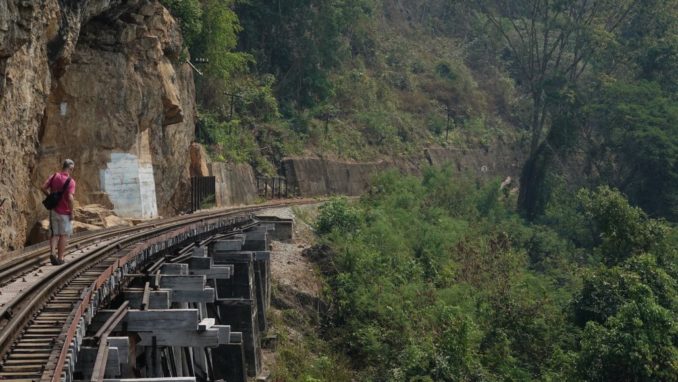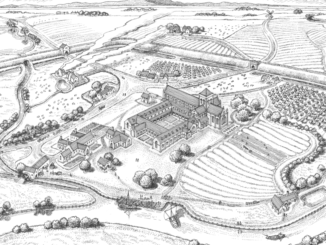David Lean’s 1957 film depicted the bridge as a significant timber structure located in the deep jungle, spanning a narrow river featuring rocks and rapids. This is of course a work of fiction and was actually filmed in Ceylon (Sri Lanka).
In reality, the POWs built two bridges over the river, the first a temporary wooden structure that was required to transport materials across the water for the construction of the iron version that still stands today. This bridge actually started life in Java which is where the Japanese dismantled it in 1942 and then transported the constituent parts to Thailand to be reassembled.
Construction started on the 26th October 1942 when 1,000 British prisoners arrived in Tamarkam, their task was to build bridge number 277 over what was then called the Mae Klong river. Four months later, the slave labour workforce was expanded when another 1,000 Dutch prisoners were also transported there to ensure the main bridge’s build schedule was maintained.
The British had constructed the first wooden bridge by the time the Dutch arrived and they then jointly set about completing their primary task, assisted by an unknown number of slave Malayans from a nearby work camp. This bridge was to become the longest on the entire railway, with eleven curved-truss spans supporting its 322m (1,056ft) length by the time it was finished just six months later, a remarkable feat given the conditions endured by the work force. The first train crossed the bridge in June 1943 and by the time of the Japanese surrender in August 1945, some 500,000 tonnes of freight had been transported across it.

Copyright Humbug 2024
The construction of the railway and in particular the bridges along its length hadn’t escaped the attention of Allied High Command and bombing raids were conducted from 29th November 1944 onwards. Once the Japanese knew that the Allies could bomb the railway they realised the line’s eight steel bridges would become the prime targets. To provide an alternative crossing of the Mae Klong River in the event of the main bridge being bombed the Japanese engineers forced the prisoners to rebuild the wooden bridge once again.
The first air raid on the bridges was conducted by the USAAF’s 9th and 493rd Squadrons. This raid caused some damage to the steel bridge but sadly a bomb fell into the nearby POW camp and a large number of men were killed and wounded. A second raid on 13th December also caused little damage.
On 5th February 1945 four squadrons carried out a large-scale raid that badly damaged the track leading to the bridges but left the bridges intact. A further attack, only four days later, finally demolished two spans of the wooden bridge but again left the steel bridge undamaged.
Late in 1944 493 Squadron stationed in India had been supplied with the newly-developed AZON (AZimuth ONly) 1,000lb bomb that featured a steerable radio controlled tail fin which was operated by the bombardier of the B-24 Liberator aircraft. On 13th February this squadron carried out the first attack on the ‘Kwai’ bridges using their new weapon. Finally, success was achieved with two spans of the steel bridge being demolished and more damage done to the timber bridge but within six weeks reconnaissance photographs showed the wooden bridge back in use so a further attack was planned. This took place on the 3rd April by two squadrons of the USAAF. Again a section of the wooden bridge was damaged.
The final air raid on the bridges took place on 24th June 1945 when B-24 bombers from Royal Air Force 159 and 356 Squadrons attacked the bridges, both of which had been repaired again. This raid destroyed three spans of the steel bridge and breached the wooden bridge in two places. The damage was so severe it ended railway operations for the rest of the war.
After taking over the line from the Allies, the State Railway of Thailand and the Japanese government rebuilt the bridge as part of a war reparations deal with the three damaged curved spans being replaced by two trapezoidal sections.

PumpkinSky, CC BY-SA 4.0, via Wikimedia Commons
Today it’s possible to walk across the bridge as only a couple of trains pass over it each day. We started from the northern end, welcomed by a pair of totally fake “bombs” which act as sentinels. Unfortunately the chance to get a tourist-free photo looking along the length of the tracks wasn’t possible due to the sheer number of tourists and so with temperatures now nudging 40 deg C we stepped out onto the hot metalwork.
To be honest I wasn’t sure what emotions I would experience as I was now stood at the very location where many of my countrymen had died, not just at the hands of their captors, but also by friendly fire either by accidental bombing of their work camps or by the Japanese forcing the POWs to walk onto the bridge during air raids in the vain hope these human shields would deter the Allied attacks. They didn’t and an unknown number of POWs died as a consequence.
The engineer in me marvelled at the construction and the subsequent repairs (you can still see the damage caused by bomb shrapnel on the concrete support structures) but I just couldn’t shake the gnawing sadness and poignancy over the events of some eighty years previous and I was happy to walk back across the bridge but extremely grateful for the opportunity to do so and also gain a far deeper understanding as to the origins of the railway, how so many POWs and slave labourers died, why the railway was vitally important to the Japanese and why it had to be destroyed.

Copyright Humbug 2024
The death toll really was horrific and the construction of the line was deemed to be a war crime committed by Japan. Why? Well for every mile of track laid, the average number of Allied deaths was 72 prisoners and when all deaths are factored in, that number rises to a shocking 460. One worker for every eleven feet of track laid. The Japanese really were barbaric in their treatment of the POWs who were deemed to be expendable. The Hellfire Pass cutting cost the lives of at least 700 Allied POWs, including 69 who were beaten to death by their Japanese guards in the twelve weeks of toil.
That four hour drive back to Bangkok gave us a long time to reflect on what we had experienced and seen for ourselves. Thailand today bears little resemblance to what it was like just eighty years ago and the exertions those poor prisoners went through to hand build this railway is so very hard to imagine. The tropical diseases, the constant starvation, the punishment beatings at the hands of murderous sadists, the mental and physical deterioration caused by near-death toil. Those men were true heroes, Japan may have been forgiven but it must never be forgotten just what they did to Allies and locals alike.
Would we recommend going out to the bridge and the railway if you’re ever in the Bangkok area? Absolutely and without hesitation. It is a long day and we could have seen so much more given additional time: the other Kanchanaburi war cemetery, the JEATH war museum, a walk through the truly-horrific Hellfire Pass etc. A two-day tour would allow for these and also the opportunity to tour more of the disused section of the railway line into the deep jungle.
We left for Bangkok knowing we’d experienced something special, taking home memories that will last a lifetime. We were lucky that we could return home, but so many men didn’t.

Copyright Humbug 2024

Copyright Humbug 2024
© SWMBO & Humbug Slocombe 2024



